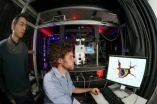(Press-News.org) Chicago (February 7, 2013): Colorectal surgical patients are often discharged from the hospital with vague guidance on how to recognize complications, but researchers at the Michael DeBakey Veterans Administration (VA) Medical Center and Baylor College of Medicine, Houston, aim to change that scenario. A health services research team convened a panel of surgical experts to develop a list of postoperative complication signs that should prompt colorectal surgical patients to call their surgeons or go to an emergency room. The study on the development of this early patient-centered warning system appears in the February 2013 issue of Journal of the American College of Surgeons.
Each year, more than 600,000 people undergo operations to treat colon and bowel disorders, including tumors, colon cancer, and bowel obstruction, according to the Society of American Gastrointestinal and Endoscopic Surgeons.* Research has also shown that 11.4 percent of all colorectal surgical patients are back in the hospital 30 days later. The stay lasts about eight days on average and costs the health care system a total of $300 million each year, according to a 2011 study published in the journal Diseases of the Colon & Rectum.†
The Patient Protection and Affordable Care Act (ACA), passed in March 2010, allows the national Centers for Medicare & Medicaid Services (CMS) to decline payment to hospitals for some patients who are readmitted after being discharged. "Many hospitals are looking at ACA and readmissions," said study author Linda T. Li, MD, research fellow at the Houston VA Health Services Research Center of Excellence and surgical resident at Baylor's Michael E. DeBakey Department of Surgery. "We're trying to see if the discharge process has anything to do with readmissions. Everything is under scrutiny."
Dr. Li and her team of health services researchers at the Michael E. Debakey VA Medical Center set out to define specific warning signs that might be important for colorectal surgical patients to watch for at home following hospital discharge. "Whether patients are discharged for a medical or surgical reason, all the discharge instructions are similar—'call if you're vomiting, having abdominal pain, or a fever,'" Dr. Li said. "We felt that surgical and medical patients are different, and there might be some specific concerns that may not be addressed by generic instructions."
Therefore, Dr. Li and her colleagues recruited a panel of 11 experts nationally recognized for expertise in colorectal operations, including surgical oncologists, colorectal surgeons, and general surgeons from academic institutions across the U.S. After a preliminary face-to-face meeting at the Academic Surgical Congress in February 2012, the panelists engaged in five rounds of intense deliberation about which warning signs are most important to notice when colorectal surgery patients get home and what should be done about these complications.
The deliberations were modeled after the Delphi method, a communication technique first used in the military and now commonly used in business forecasting and policy making. The technique required that all feedback be given anonymously. "The thought is that collective knowledge is better than one person's expertise," Dr. Li explained. "Everyone is an established expert in the field, but we didn't want any panelist to think that if a doctor is from a particular institution, 'He or she must be right, I'll just agree with what he or she says.'"
Each round of deliberations started with questions like "describe at least 10 symptoms you would warn your patients about," then "rate these warning signs in order of importance and explain [why]." After Dr. Li and her team compiled the responses, the answers and comments of the group were e-mailed to all panelists along with the next round of questionnaires.
Even though discharge instructions are relatively standardized, Dr. Li said the wide spectrum of opinions underscored why the study was necessary. "Everyone seemed to have a different definition of the same symptom," Dr. Li said. "When we were talking about a fever, the temperature could be 101, 102, or 100.4."
"One of the interesting things about the Delphi process is that we summarize what everyone says," Dr. Li added. "So if you were the only one who said a fever is 102, but everyone else thinks it's 100.4, you might join the group or explain why on the next round of feedback."
After five rounds, between February and July 2012, the panel of surgeons came up with 10 symptoms that should prompt patients to contact their surgeons:
wound drainage, opening, or redness (all three of these signs can indicate an infection)
no bowel movement or lack of gas/stool from any ostomy for more than 24 hours
increasing abdominal pain
vomiting
abdominal swelling
high ostomy output and/or dark urine or no urine
fever greater than 101.5
not being able to take anything by mouth for more than 24 hours
The panel also identified two symptoms that are serious enough to warrant a trip to the nearest emergency department:
chest pain
shortness of breath
Dr. Li said the study is the first step toward incorporating these warning signs into already established discharge instruction tools. This surgical patient education process should help colorectal surgical patients have clear, open communication with surgeons when they feel something is wrong. "Regarding health care use," the authors wrote, "all panelists agreed that warning signs should decrease emergency care visits and readmission, triage the level of health care accessed, and increase patient-to-provider communication."
Other participants in the study included Whitney L. Mills, PhD; Amanda M. Gutierrez; Levi I. Herman, BS; David H. Berger, MD, MHCM, FACS; and Aanand D. Naik, MD.
###
Resources and support from the Houston Veterans Administration Health Services Research and Development Center of Excellence (HFP90-020).
References
*Patient information for laparoscopic colon resection from SAGES. Society of American Gastrointestinal and Endoscopic Surgeons. Available at http://www.sages.org/publication/id/PI09/(.) Accessed February 6, 2013.
† Wice EC, Shore AD, Hirose K, et al.
Readmission Rates and Cost Following Colorectal Surgery. Dis Colon Rectum 2011 Dec; 54(12):1475-9.
Citation: Journal of the American College of Surgeons, February 2013: Vol 216(2): 210-216.e6.
About the American College of Surgeons
The American College of Surgeons is a scientific and educational organization of surgeons that was founded in 1913 to raise the standards of surgical practice and improve the quality of care for all surgical patients. The College is dedicated to the ethical and competent practice of surgery. Its achievements have significantly influenced the course of scientific surgery in America and have established it as an important advocate for all surgical patients. The College has more than 79,000 members and is the largest organization of surgeons in the world. For more information, visit www.facs.org(.)
END
The hippocampus – a structure of the brain whose shape resembles that of a seahorse – is also called the "gateway" to memory. This is where information is stored and retrieved. Its performance relies on new neurons being continually formed in the hippocampus over the entire lifetime. "However, in old age, production of new neurons dramatically decreases. This is considered to be among the causes of declining memory and learning ability", Prof. Dr. Ana Martin-Villalba, a neuroscientist, explains.
Martin-Villalba, who heads a research department at the German Cancer Research ...
(SACRAMENTO, Calif.) — Scientists have long puzzled over why "bad" bacteria such as E. coli can thrive in the guts of those with inflammatory bowel disease (IBD), causing serious diarrhea. Now UC Davis researchers have discovered the answer—one that may be the first step toward finding new and better treatments for IBD.
The researchers discovered a biological mechanism by which harmful bacteria grow, edge out beneficial bacteria and damage the gut in IBD. This new understanding, published in the Feb. 8 issue of Science, may help researchers develop new treatments for ...
Jacob Rutt is a bright 11-year-old who likes to draw detailed maps in his spare time. But the budding geographer has a hard time with physical skills most children take for granted -- running and climbing trees are beyond him, and even walking can be difficult. He was diagnosed with a form of muscular dystrophy known as Duchenne when he was two years old.
The disease affects about 1 in 3,500 newborns -- mostly boys -- worldwide. It usually becomes apparent in early childhood, as weakened skeletal muscles cause delays in milestones such as sitting and walking. Children ...
A single embryonic stem cell can develop into more than 200 specialized cell types that make up our body. This maturation process is called differentiation and is tightly regulated. If the regulation is lost, specialized cells cannot develop correctly during development. In adulthood, the specialized cells may forget their identity and develop into cancer cells. Research from BRIC, University of Copenhagen, has identified a crucial role of the molecule Fbxl10 in differentiation of embryonic stem cells and suggests the molecule as a new potential target for cancer therapy.
"Our ...
Highlights of this news release:
Six-month study finds that progestin-releasing contraceptives show a slight negative impact on metabolic markers, raising the risk for type 2 diabetes.
Contraceptive implants under the skin increase the risk more than uterine implants.
Longer and larger studies are needed to see if metabolic changes are temporary or long-term.
LOS ANGELES – A first-of-its-kind study by researchers at the Keck School of Medicine of the University of Southern California (USC) indicates that healthy, obese, reproductive-age women who use long-acting ...
Fishing communities living on the islands of Indonesia's Karimunjawa National Park have found an important balance, improving their social well-being while reducing their reliance on marine biodiversity, according to the Wildlife Conservation Society and the University of Western Australia.
Over the past 5 years, the Government of Indonesia has turned Karimunjawa National Park—a marine paradise of turquoise seas and mangrove-ringed islands in the Java Sea just south of Borneo—into a model of co-management for the country, largely by increasing community participation ...
ARGONNE, Ill. – Although scientists have been aware that magnetism and electricity are two sides of the same proverbial coin for almost 150 years, researchers are still trying to find new ways to use a material's electric behavior to influence its magnetic behavior, or vice versa.
Thanks to new research by an international team of researchers led by the U.S. Department of Energy's Argonne National Laboratory, physicists have developed new methods for controlling magnetic order in a particular class of materials known as "magnetoelectrics."
Magnetoelectrics get their ...
Triple-negative breast cancer is an aggressive form of breast cancer that has few treatment options;
This large-scale study shows that abnormal levels of small molecules called microRNA can be used to classify this malignancy into four subtypes;
The findings could lead to new ways to identify the best therapy for individual patients and to more effective therapies in the future.
COLUMBUS, Ohio – A new, large-scale study of triple-negative breast cancer shows that small molecules called microRNA can be used to define four subtypes of this aggressive malignancy.
The ...
In the world of microscopy, this advance is almost comparable to the leap from photography to live television. Two young EPFL researchers, Yann Cotte and Fatih Toy, have designed a device that combines holographic microscopy and computational image processing to observe living biological tissues at the nanoscale. Their research is being done under the supervision of Christian Depeursinge, head of the Microvision and Microdiagnostics Group in EPFL's School of Engineering.
Using their setup, three-dimensional images of living cells can be obtained in just a few minutes ...
WASHINGTON –Requiring individuals to pay a premium for public health insurance coverage can counteract the coverage effects of expanding eligibility for public health insurance programs to higher income families.
That is the finding of a study by a team of researchers from Georgetown University School of Nursing & Health Studies (NHS), University of California at Los Angeles (UCLA), and Columbia University published today in the journal Health Services Research.
"Our findings speak to the importance of not just the availability of insurance coverage, but also the ...


